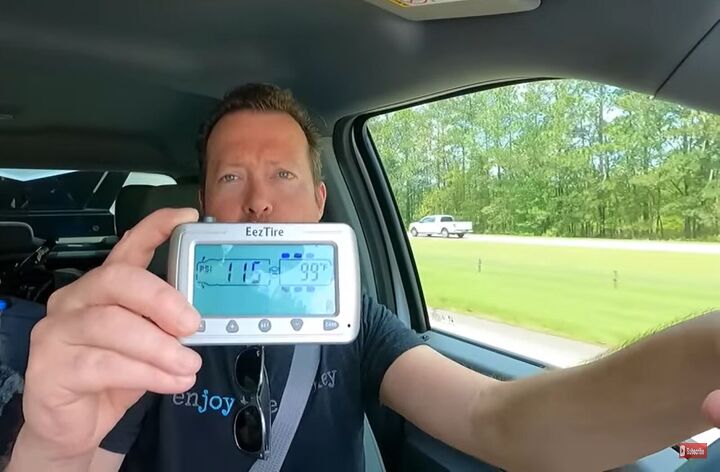7 Important Tips For RV Tire Repair That Could Save You Thousands

I didn’t watch many YouTube videos on what to avoid with an RV when I started my RV journey. I had to learn the hard way through experience. RV damage is costly and potentially dangerous. I found this out recently when I had a tire blowout, so today I wanted to talk to you all about RV tire repair.
1. Insurance vs Roadside Assistance
When our tire blew out, a Road Ranger stopped and attempted to help. He looked at it, did a few things, but didn’t really get the job done. With a Road Ranger, there's nothing coming out of our pocket, but they're not really motivated to help you.
Roadside Assistance may be fine for changing a car tire, but for an RV, deal with your insurance. An insurance company like Progressive Roadside knows they need to send someone that can deal with an RV. You can get a hold of them quickly and they can text you and know your location right away.
2. Dangers of blown RV tires
Blown tires can cause tens of thousands of dollars’ worth of damage to your RV. The rubber of RV tires gets so hot, that when it ruptures and flies all around, it can create all sorts of additional damage to other parts of the vehicle.
I've seen ruptures that ripped apart the whole underside of the RV. Another danger is that one tire blowing out can cause another tire to blow out, and you can flip your rig.
RV tires should be replaced every 5 years. They carry so much weight they age out. To make sure your tires are not expired, check the manufacture date, not the purchase date. Just because you bought your tires last year doesn’t mean they are a year old. They could have been manufactured a year or two before you purchased them.
To find the manufactured age of your tires, look for a round oval on your tire with 4 numbers. The number on my tire says 1318. That means it was manufactured in the 13th week of 2018.
3. Get your RV weighed
As soon as you get your RV, check the weight to make sure the tires are the right rating. Manufacturers are notorious for providing the cheapest tires. Our previous RV had Load Range E tires so I upgraded them to Load Range G. Be sure that you've got the right kind of tire on your RV before you go on any trips.
4. TPMS system
Always check your tire pressure while they are cold. If you've been driving around the tires are hot and the pressure is a lot higher.
My G-rated tires are made to have 110 PSI cold so that’s what I put into them. I run them all at 110 so I get the best fuel economy. Some people may run them at 100 or 105 because they don't want to put them at the max, but they are made to be at the max with cold pressure.
I recommend getting an air inflator. You need to have an air inflator that's powered with a 12-volt connection so you can easily adjust your tire pressure as needed.
I also have a TPMS system that has alarms set on the high end and the low end. When you're on the road and your tires get too hot, you can stop and let some air pressure out. Mount your TPMS monitor inside your vehicle somewhere you can easily see the temperature and how your tire pressures are doing as they heat up while you're driving.
5. Bad RV advice
Every time I’ve gone to an RV repair person or had the RV in the shop I've asked if they need to rotate the tires. They always say there’s no need and act like it’s a strange question, but these rear tires on triple-axle RVs take a ton of abuse. Since rear tires take most of the abuse it makes sense that you would rotate them forward to share some of that abuse with the other tires.
I did a quick online search on Google and there are lots of blogs and articles about this. You need to rotate your RV's tires like a car. Why is it that every expert that I talk to says no? It’s hard to say, but consider where you're getting your RV advice.
The worst RV tire advice that I received was when we bought our first RV. The manager at the dealership recommended buying used tires to replace the current ones. I was a total newbie, so I bought used tires and they all blew. It was terrible advice. I saved $20- $30 on a tire that ended up causing thousands of dollars of damage.
6. Full-time RV usage
RVs are junk. I hate to say it, but there are very few exceptions to that rule. RVs are mass-produced. Cheap parts are often put into them that may be enough for part-time use, but if you’re using your RV full time, like a house, you're going to have issues. Most RVs were not designed for full-time travel.
7. Extended warranty
Because of our extended warranty, we were able to get a brand-new tire when we had our blowout.
At that time we also had several other issues in the RV. Our microwave was broken, the fan in the bathroom went out, and the hot water heater wasn't working. The damage came to about $1,500, not including the tire, but it was all covered except for a small deductible.
The extended warranty covers you if you're a full-time RVer and has lots of extras. Your RV can be up to 20 years old and still covered. An older RV will have a lot of issues, so you’ll need that coverage.
Tips for RV tire repair
Make sure you have the right tires for the weight of your RV. Don’t drive on old, worn tires. Check your tire pressure. Get the right kind of coverage and insurance. Take this advice and you'll avoid damage to your RV and your wallet.
Let me know your RV tire repair stories in the comments below.






















Comments
Join the conversation
When you first get your RV, it’s easy to fall into “fantasy” RV trip mode. Thanks for the “truth-telling”.